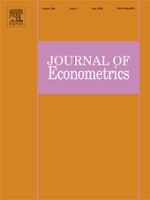We analyze a time series of global temperature anomaly distributions to identify and estimate persistent features in climate change. We employ a formal test for the existence of functional unit roots in the time series of these densities, and we develop a new test to distinguish functional unit roots from functional deterministic trends or explosive behavior. Results suggest that temperature anomalies contain stochastic trends (as opposed to deterministic trends or explosive roots), two trends are present in the Northern Hemisphere while one stochastic trend is present in the Southern Hemisphere, and the probabilities of observing moderately positive anomalies have increased. We postulate that differences in the pattern and number of unit roots in each hemisphere may be due to a natural experiment which causes human emissions of greenhouse gases and sulfur to be greater in the Northern Hemisphere, decreasing the mean temperature anomaly but increasing the spatial variance relative to the Southern Hemisphere. Together, these results are consistent with the theory of anthropogenic climate change.
Evaluating trends in time series of distributions: A spatial fingerprint of human effects on climate
Evaluating trends in time series of distributions: A spatial fingerprint of human effects on climate
- Yoosoon Chang, Kaufmann, Robert K., Kim, Chang Sik, Miller, J. Isaac, Joon Y. Park, Park, Sungkeun
- Publication Date
2020
 The College of Arts
The College of Arts